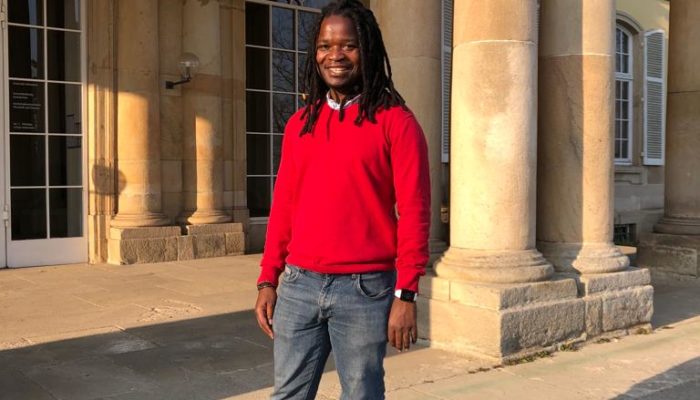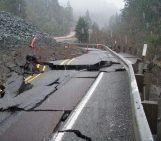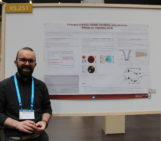
Hello Abraham. Thank you for speaking with us today! Could you tell our readers a bit about yourself and your research?
Thanks, Simon! It’s a pleasure to be invited to share about my work.
Well, where do I begin?
For starters, I’m a Genus Postdoctoral Fellow at the University of the Witwatersrand in Johannesburg, South Africa. I describe myself as an early-career African ecologist with a keen interest in understanding how ecosystems behave across space and time. I’m particularly interested in grassland and savanna biomes where fires, large herbivores, and humans are implicated in the development and maintenance of these open grassy ecosystems in Africa and beyond.
I’ve worn several hats that reflect my research journey, but similar ideas run through the veins of my work. My PhD focused on understanding long-term ecosystem dynamics of grassland and savanna ecosystems using palaeo-ecology. For my Master of Science, I was fascinated by conservation biology and movement patterns of large selective grazers. Lastly, my Bachelor of Science studies were in natural resource management. I can roughly say my research is about reconciling successful ecological ideas from relevant spatial and temporal scales, using those insights to understand the development and maintenance of open grassy ecosystems, and finding new ways to effectively integrate the lessons to conserve, manage, and restore grassy ecosystems in Africa.
At the moment, my palaeo-ecologist research hat is dominant. For readers who may be unaware what palaeo-ecologists do, I for one use microscopic fossils or material of biological origin to reconstruct vegetation, fire, herbivore histories or dynamics. I mostly work with deposits from sedimentary environments such as lakes, wetlands, and pans. Because I care about dynamic relationships, I combine and review evidence from multiple proxies including fossil pollen, phytoliths, fossil coprophilous fungal spores, charcoal, and elemental analyses.
Open grasslands and savanna evoke imagery of a vast natural landscape grazed upon by ponderous herbivores, but your research suggests that grasslands themselves are the product of centuries of grazing, fires, and indigenous pastoralists. Can you tell us more about the dynamics that shape grasslands?
Well, thanks for the flattery, Simon! My work, really…?
I think it’s humbler to say that what I found in my research reflects a now accepted view by key African ecologists. This view that climate is not the primary driver of observed patterns of open grassy ecosystems has taken time to catch-on, but is now seeing light. I’m indebted in my research to pioneering ideas of leading Africa ecologists who have considered this problem from ecological to evolutionary timescales, e.g., my PhD supervisor Professor William Bond’s reflections on fire and Professor Norman Owen-Smith’s work on large mammal herbivores. Their work brings to the fore ideas about ecosystem functional traits, i.e., key adaptations of plants to frequent disturbances by fire and herbivory. These adaptations are indicated by plant physiognomy (size, shape, growth-form) and physiology, and guarantee persistence of plant species/ communities in dynamic environments.
What my work at the scale of 2000 years showed is that climate, humans, fire, and grazing are important drivers of dynamic open grassy vegetation states, i.e., fire versus herbivore dominated grass states. However, because at my study sites grass evidence was from local-scale and from regions with rainfall variability from interannual to millennial timescales, these wetlands were likely key resource areas for sustaining large herbivore and human populations during climate stress. In this context, wetland sedimentary records have episodic relevance linked to hydro-climatic variability and give limited spatial extrapolation as filtering of local plant species by herbivores is likely stronger than fire when human influence is minimal.
Nevertheless, if we consider local wetland environments at grassy ecosystems as tightly connected to vegetation in wider landscapes, then dynamics observed in sedimentary records become meaningful. I know, this is rather a long and winded response, but dynamics are very complicated at small-scale, and linking multiple scales remains a key challenge in ecological theory and practice. But the magic here is that we now know that plant functional traits reflect past disturbance histories of alternate fire- or herbivore-dominated open vegetation states from multiple lines of palaeoecological proxy evidence, and that these conclusions probably hold true for open ecosystems at much larger spatial or temporal scales.
So, Simon, we can safely say that people and large herbivores in Africa are responsible for maintaining open landscapes at very long timescales. Particularly, people’s influence on fire and large herbivore dynamics. This results in heterogeneous landscapes with multiple disturbance histories and functions, which is important for maintaining biodiversity and ecosystem stability. This should make us reflect on our “nature heritages” and future ecosystem persistence.
I know many people find it difficult to reconcile the fact that indigenous people and herbivores shaped present ecosystems, especially as the prevailing narrative is that people are bad for the environment and “plant more trees!” These backward and unreflective ideas in ecology, conservation, and science marginalises indigenous communities and harm ecosystems they aim to “protect.”
While we cannot deny that populations of humans and their livestock have increased in the last century, we must also acknowledge that native herbivores in Africa were nearly hunted to extinction non-indigenous people.
From colonialism to industrialisation, the recent centuries have shaken the formative dynamics of the grasslands. Climate change promises that grasslands will continue to change. How have such changes impacted the grassland ecosystems?
Grassy ecosystems and other terrestrial ecosystems are not immune to effects of human socio-economic modes of production or climate change. In fact, these two are currently considered important large-scale drivers of land cover in grassy ecosystems.
I cannot speak about other continents, but in Africa, human societal modes of economic production and values changed from pre-colonial, colonial, and industrial revolution, probably influencing the scale and magnitude of ecological transformation. The last two periods are marked by a higher number of ecological transitions.
One of the key challenges faced by palaeo-ecologists is functionally distinguishing ancient from derived grassy ecosystems. It is clear that in some regions or landscapes, forests were lost through conversion to derived savannas and grasslands. But in other regions, losses of large indigenous herbivores, land tenure, farming and extractive practices like overgrazing and deforestation, and government policies suppressing fire led to closed woodlands at the expense of vegetation adapted to frequent disturbances. Of course, this had knock-on effects on indigenous peoples’ livelihood, habitat quality, nutrient cycling, and biodiversity patterns.
I won’t discuss climate because much has been said and written about it. However, rising atmospheric carbon dioxide concentrations and global temperatures will likely lead to changes in the amount and seasonality of rainfall. More carbon dioxide will increase photosynthesis rates of trees compared with tropical grasses. An alarming prediction is that tropical grasslands and the rich biodiversity they support will be replaced by closed woodlands and forest. So, rising carbon dioxide to the level last experienced millions of years ago is worrying!
Since its management by pastoral communities, grassland conservation is now often directed by large, sometimes global, organisations. Do you think conservation and restoration efforts are going in the right direction?
Wow, what a question. A good one at that, one which causes me to ponder much and really ask myself about the future of grasslands.
The transition from decentralised, laissez-faire, “natural” patch-based management of landscapes by pastoralists to the prescriptive, centralized, and powerful organisations like governments and corporations is cause for concern. In my opinion, this will be the undoing of many “well-meaning” restoration efforts and an affront to the development of ecosystems, society, and restoration science. Let me explain why I am of this contrarian view.
I think I mentioned earlier that one of the key features of open grassy ecosystems is heterogeneity, i.e., disturbances create patches at various stages of development, with many plants adapted to aforementioned disturbances. This suggests that across the continent, there is much variation between and within savannas and grassland owing to multiple disturbance histories.
Pastoralists played a key role in generating some of these patterns we take for granted in the last 3000 years or so, and before them, hunter-gatherer societies probably kept wildlife on the move. What this effectively means is that landscapes have been subject to multiple “discourses” at the whims of intersections between man and nature.
The shift to centralised, science-driven, and government or corporate management of ecological restoration in open grassy landscapes is philosophically challenging. How can structured monolithic organisations generate meaningful heterogeneity, i.e., locally-relevant variations in grasslands? Who is consulted for such decisions, and why? A key question from the Global South (Africa, South America, and Asia) where many pastoralists still live is where does the “science” supposedly shaping the future come from? The shift from government to corporate control is worse as it takes away power from local actors and national sovereignty. Judging from the history of government agencies privatising public goods like water and energy, corporatisation restoration seems a sure recipe for disaster as conservation does not create tangible profits since it is a public good. Therefore, shifts in power dynamics that can occur from such a transfer of power and rights is potentially catastrophic, especially in the Global South as it will lead to rising economic inequality and social instability.
At the root of the problem is the so-called “science” guiding the shift from decentralised to centralised resource control. We should ask ourselves this philosophical question as conservation scientists: do we aim for eco-fascism where natural resources are used to control power or restoration science as a tool for driving meaningful social and ecological changes? I’m of the latter view where science is used to enhance inclusion, diversity, and equity in restoration practices from diverse regions. Just because grasslands have apparently similar problems does not mean their solutions should converge, just like the heterogeneous nature of open grassy ecosystems we gain from studying the past and present.
Finally, what does the future look like for you?
I’m an optimist at heart and look forward to the future. I’m always hungry to learn more about grasslands and finding new ways to synthesize knowledge linking the past-present-future continuum in evolution, ecology, and conservation sciences. There is so much to do, our field is very exciting and bracing for change. This means I look forward to working on aligned research problems with people from different regions, disciplines, and cultures. In that way, I can produce research that is fun and valuable to me, hopefully inspire many people, and help conserve our precious open grassy ecosystems.




